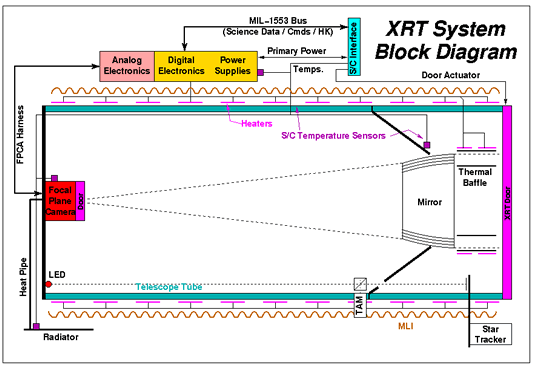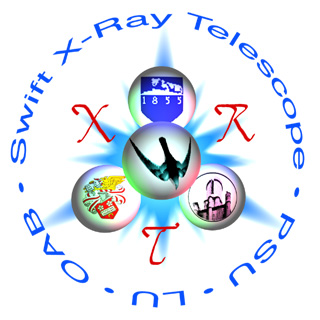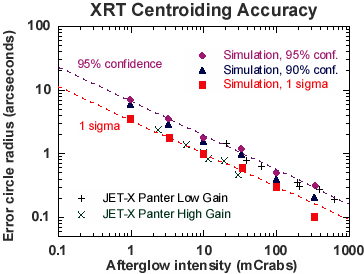
XRT Overall Description

The XRT uses a grazing incidence Wolter I telescope to focus X-rays onto a state-of-the-art CCD, providing an instrument with 110 cm2 effective area, 23.6 arcmin FOV, 15 arcsec resolution (half-power diameter), and 0.2-10 keV energy range. The layout of the instrument is shown in at the right. A door (pink) based on the JET-X door protects the mirrors during launch. Thermal baffles (purple) provide a warm environment for the front end of the mirrors and prevent any thermal gradients across them from distorting the Point Spread Function (PSF). The mirrors themselves are the FM3 unit manufactured for the JET-X program as flight spares, and are already built, qualified and calibrated. A composite telescope tube holds the focal plane camera (red), which contains a single EEV CCD-22 detector (originally designed for the XMM/EPIC program). The tube extension to the right of the mirrors acts as a sunshade. A thermal radiator at the rear of the instrument is coupled to a Peltier cooler that cools the detector to -110 C.
XRT Instrument Characteristics

Swift X-Ray
Telescope
|
Telescope | JET-X Wolter I |
| Focal Length | 3.5 m | |
| Effective Area | 110 cm2@ 1.5 keV | |
| Telescope PSF | 18
arcsec HPD @ 1.5 keV 22 arcsec HPD @ 8.1 keV |
|
| Detector | MAT CCD-22, 600 x 602 pixels | |
| Detector Operation | Imaging,Timing, and Photon-counting | |
| Detection Element | 40 x 40 micron pixels | |
| Pixel Scale | 2.36 arcsec/pixel | |
| Energy Range | 0.2-10 keV | |
| Sensitivity | 8 x 10-14 erg cm-2s-1 in 10^4 s |
XRT Science Requirements
There are 3 primary science requirements that drive the design of the XRT: rapid, accurate positions; moderate resolution spectroscopy; and high time resolution lightcurves.
GRB Position Determination: The XRT
is required to provide afterglow positions with uncertainty of 5
arcseconds within  100 s of the burst alert from the BAT. Based on Beppo-SAX
and RXTE observations of X-ray counterparts of GRBs, we expect
that most GRBs observed by Swift will have X-ray fluxes of
roughly 0.5 - 5 Crabs in the 0.2-10 keV band. Figure FO-1b shows
a simulated XRT image of a GRB, made using raytracing code
developed for JET-X and Beppo-SAX and incorporating
the measured PSF of the XRT mirrors. The mirror Point Spread
Function has a 15 arcsecond Half-Energy Width, and the centroid
of a point source image can be determined to much better sub-arcsecond
accuracy (in detector coordinates), given sufficient photons. JET-X
calibration data and detailed Monte Carlo simulations of XRT observations
both show that the XRT will obtain source positions to better
than 1 arcsecond in XRT detector coordinates for typical
afterglows within 5 seconds of target acquisition (right). When
this position is referenced back to the sky, the expected error
is about 2.5 arcseconds, due mostly to the alignment uncertainty
between the star tracker and the XRT (Swift Alignment
Team report.
100 s of the burst alert from the BAT. Based on Beppo-SAX
and RXTE observations of X-ray counterparts of GRBs, we expect
that most GRBs observed by Swift will have X-ray fluxes of
roughly 0.5 - 5 Crabs in the 0.2-10 keV band. Figure FO-1b shows
a simulated XRT image of a GRB, made using raytracing code
developed for JET-X and Beppo-SAX and incorporating
the measured PSF of the XRT mirrors. The mirror Point Spread
Function has a 15 arcsecond Half-Energy Width, and the centroid
of a point source image can be determined to much better sub-arcsecond
accuracy (in detector coordinates), given sufficient photons. JET-X
calibration data and detailed Monte Carlo simulations of XRT observations
both show that the XRT will obtain source positions to better
than 1 arcsecond in XRT detector coordinates for typical
afterglows within 5 seconds of target acquisition (right). When
this position is referenced back to the sky, the expected error
is about 2.5 arcseconds, due mostly to the alignment uncertainty
between the star tracker and the XRT (Swift Alignment
Team report.
Spectroscopy: X-ray spectroscopy will provide
important information on the GRB/afterglow properties. The GRB itself
is  produced by internal shocks, while the afterglow is produced by
external shocks with the ambient medium. These external shocks heat
the surrounding medium to extremely high temperatures, and the gas
radiates through characteristic emission lines and continuum as
it cools. It can also be absorbed by cooler gas in the host galaxy.
Observations of the X-ray spectrum may therefore detect emission
lines or absorption edges, which can provide direct information
on such parameters as the composition and ionization structure of
the shocked gas and the redshift of the GRB source (Ghisellini et
al. 1999, Astrophysical Journal, 517, p. 168). An example is shown
in the spectrum to the left, where a strong 6.4 keV Fe line at z=1.0
is measured with 1% accuracy in redshift. (The line is red-shifted
to an apparent energy of 3.2 keV, and is apparent as a large positive
deviation at that energy in the lower plot of residuals between
the data and the continuum model.)
produced by internal shocks, while the afterglow is produced by
external shocks with the ambient medium. These external shocks heat
the surrounding medium to extremely high temperatures, and the gas
radiates through characteristic emission lines and continuum as
it cools. It can also be absorbed by cooler gas in the host galaxy.
Observations of the X-ray spectrum may therefore detect emission
lines or absorption edges, which can provide direct information
on such parameters as the composition and ionization structure of
the shocked gas and the redshift of the GRB source (Ghisellini et
al. 1999, Astrophysical Journal, 517, p. 168). An example is shown
in the spectrum to the left, where a strong 6.4 keV Fe line at z=1.0
is measured with 1% accuracy in redshift. (The line is red-shifted
to an apparent energy of 3.2 keV, and is apparent as a large positive
deviation at that energy in the lower plot of residuals between
the data and the continuum model.)
The requirement is for the XRT to provide spectra with 200 eV resolution at 6 keV within 1200 seconds of the burst. The XRT resolution at launch will be about 130 eV at 6 kev, and spectra similar to that shown here will be obtained routinely. The resolution will degrade during the mission, but remains below 200 eV at end of life for a worst-case radiation environment. We will transmit spectra like these to the ground through our TDRSS link within 300 seconds of the BAT burst alert.
Lightcurves: The XRT is required to provide accurate photometry and lightcurves with at least 50 ms time resolution. Two timing sub-modes will be implemented, based on the timing modes used on JET-X and XMM/EPIC: high timing mode, which gives the highest time resolution at 0.5 ms, and medium timing mode, which is less susceptible to contaminated fields and provides about 4 ms time resolution. Photometric accuracy will be good to 10% or better for source fluxes ranging from our sensitivity limit of 8x10-14 ergs/cm2/s to roughly 8x10-7 ergs/cm2/s (about 4 times brighter than the brightest X-ray burst observed to date). With this capability, the XRT can make crucial determinations of time structure in the afterglow. Time variations (DT/T) as small as 1/300 can be observed and used to study internal to external shock transitions.
Swift Mission Operations Center
The Pennsylvania State University301 Science Park Road,
Building 2 Suite 332,
State College, PA 16801
USA
☎ +1 (814) 865-6834
📧 swiftods@swift.psu.edu
Swift MOC Team Leads
Mission Director: John NousekScience Operations: Jamie Kennea
Flight Operations: Mark Hilliard
UVOT: Michael Siegel
XRT: Jamie Kennea
Swift Partners
UK: UCL MSSL Univ. of LeicesterUSA: NASA/GSFC LANL Omitron SwRI
Italy: SSDC/ASI INAF OA-Brera